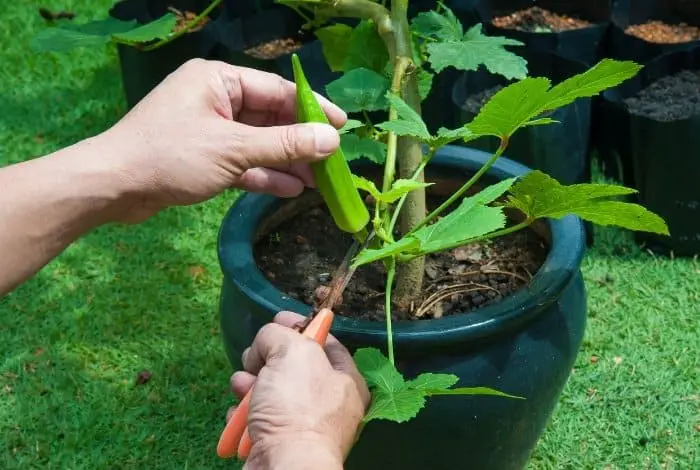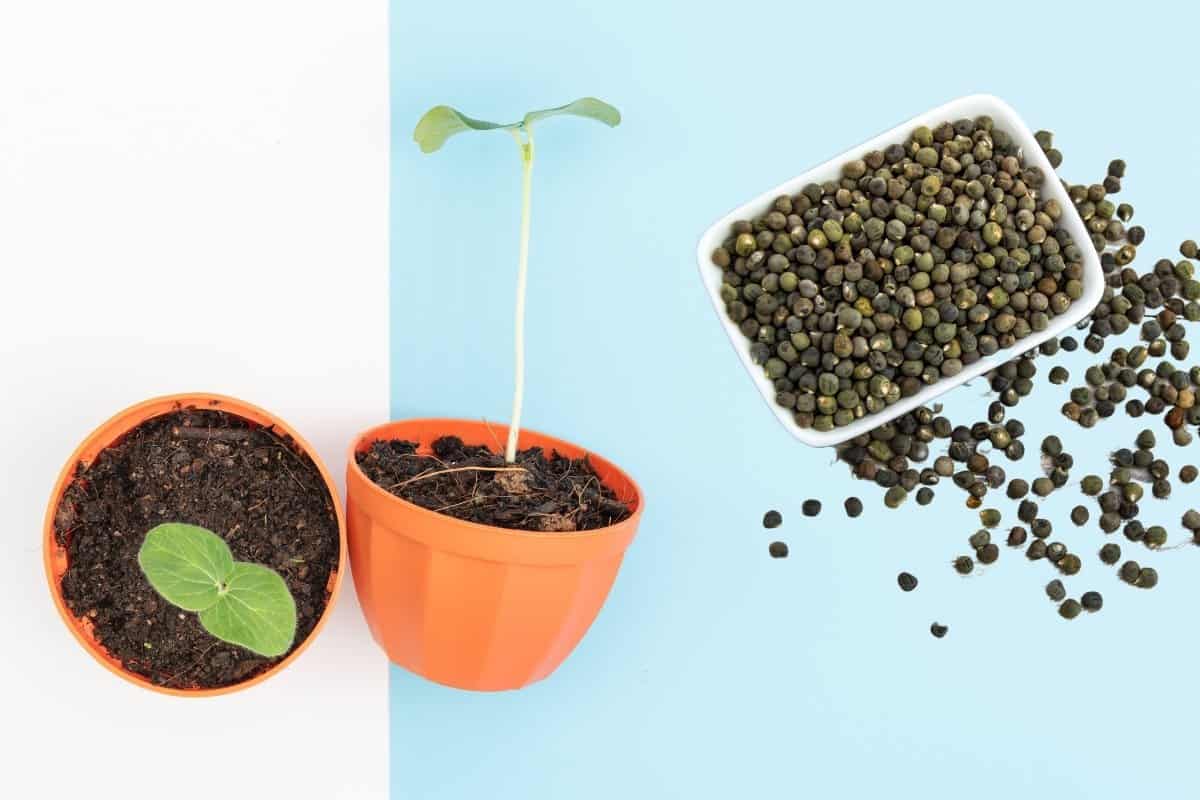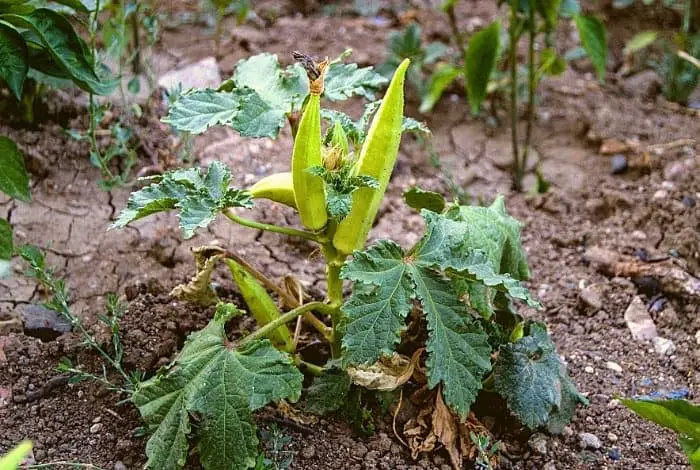Last Updated on February 3, 2023 by Griselda M.
Knowing how to plant okra step by step is crucial to ensure you do not destroy the seeds at the start of their journey.
Okra, also known as (Abelmoschus esculentus) is native to Africa. These edible green seed pods arrived in North America in the 1600s and quickly became a staple to the South as well. It is loved both as a staple and a thickening agent for stews and gumbo.
Okra thrives in any climate where corn does well. These large-flowered fast-growing plants reach up to 2 to 6 feet tall depending on the type of cultivar.
It has a similar taste to eggplant and is commonly used in shellfish, tomato, onion, and corn dishes. This plant is related to hibiscus, the rose of Sharon, and hollyhock.
Are Okra Seeds Good for You?
So, are okra seeds good for you? Okra is known by many names, which include lady’s fingers, gumbo, and bhindi, amongst others. They are extremely good to eat as they are an excellent source of fiber, antioxidants, vitamins, and minerals, which are beneficial.
Additionally, the sticky substance that it contains is often used in the juice thickening process. This nutrient-rich vegetable is widely consumed throughout the world and is most popular in the Southern parts of the United States, South America, the Middle East, Africa, and the Caribbean. It is appreciated for its mild taste and unique texture with edible seeds.
Nutritional information of 100 grams of Okra according to USDA Standards:
- 31.3g of vitamin K
- 33 calories
- 1.5g of sugar
- 3.2g of fiber
- 7.5g of carbs
- 0.2g of fat
- 1.9g of protein
Additionally, okra also contains potassium, sodium, vitamin C, thiamin, magnesium, calcium, vitamin B6, folate, vitamin A, iron, niacin, copper, and phosphorus.
Where to Buy Dreamlight Valley Okra Seeds?
Knowing where to buy Dreamlight Valley okra seeds will save the hassle of going on the hunt to find the right information. Disney Dreamlight Valley includes a large amount of farming; therefore, knowing how it all works would be beneficial in reaping the rewards that you put effort into when sowing the okra seeds. Also, knowing how farming works in this game and where to purchase the okra seeds will ease the whole process substantially.
You will also find that although Okra takes longer to grow, they are quite profitable. In the Dreamlight Valley, the late of Trust is the purchasing stall for Okra seeds. The seeds growing time is estimated at 120 minutes and also has a seed price of 135, a selling price of 114, and a harvest expectation of 3. These seeds can be planted anywhere in the valley by using a shovel to dig up a planting spot.
Thereafter, your gaming adventure in the valley will begin after the seeds are sowed. Any number of crops can be planted in the valley by you. Characters which include Goofy and Moana will be your sources in this farming adventure. To get the most profitable return for your buck, monitoring the best profit per minute in the Dreamlight Valley is recommended.
Okra Growing Tips
We have put together some of the best okra-growing tips for you in this guide. With these expert tips, you should have no hassle growing these delicious vegetables in your own garden. Hot weather conditions are favored by the lady’s finger plant because it is known to thrive in the South. However, in recent reports, it was found that many people in the Northern parts of the US favor these warm-natured hibiscus cousin plants. Take heed of the growing tips below and enjoy abundant okra harvests/
Tips for growing okra:
- – Okra should be planted during the warmer seasons for the best results. Monitoring evening temperatures until they are consistently in the 60s or higher is a great indication to start growing them.
- – When planting okra, affording them at least 10 inches of space between each other is recommended.
- – Okra thrives in direct sunlight, so ensure that they are planted in an open space.
- – Fertile soil with excellent drainage properties is best for growing ladies’ finger plants. Keep in mind that okra thrives in slightly acidic to neutral soil so a pH of 6.5 to 7.0 is ideal.
- – If you have native soil that is nutrient-dense, enriching it with rich organic matter like compost will give you healthy, delicious okra.
- – Although okra is drought tolerant to an extent, feeding your plant an inch of water per week is highly advised.
- – Regular feeding of slow-release plant food or fertilizer that is continuous will increase the okra yield.
- – Ensure that your okra pods are about two or four inches in length when harvesting.
Guide For How To Plant Okra Seed
Okra requires full sun to thrive. It grows in ordinary garden soil, especially fertile loam soil. Plant them after growing nitrogen-fixing crops like peas and they will do very well.
Plant a first crop of Okra in the early spring and a second in June in the South. In the short-season areas, plant them indoors 6 weeks before setting them out – 3 to 4 weeks after the last frost date. Plant 2 seeds per pot and clip off the weaker seedling in the first few weeks.
If you choose to plant Okra seeds in the ground, wait until the soil is warm and the air temperature reaches 60 degrees. Use fresh seeds soaked overnight to encourage germination.
Sow your seeds ½ inch deep in light soil and 1 inch deep in heavy soil. Space your seeds 3 inches apart in rows that are 3 to 4 feet apart. Thin out the weak seedlings at least 18 to 24 inches apart keeping the strongest among your plants. If you use transplants, space them at least 1 to 2 feet to give them ample room to grow.
The Best Time To Plant Okra Seeds
You can start Okra seeds indoors in pots full of peat 3 to 4 weeks before the last frost date using indoor light.
In warmer areas, you can plant Okra directly in your garden 3 to 4 weeks before the last spring frost date. You will need to cover your plants with a grow tunnel or a cold frame until the weather warms up. Make sure the coverage you use is at least 2 to 3 feet to give the plants room to grow.
If you do not start your Okra plants early, you can wait until the weather is stable and warm. Your garden is ready for okra seeds when the soil is warm to about 65 to 70 degrees. Remember, the warmer, the better.
Choosing and Preparing The Planting Site
Choose an area that receives full sun.
Okra is adaptable to most soils but you must use well-draining soil that is rich in organic matter.
Soil should be acidic with a pH value of 5.8 to 7.0.
Caring For The Okra Plant
Watering
Provide regular watering during the flowering and pod development. If the weather is dry and hot, you will need to water them every week with adequate water.
Diseases and Pests
Plant Okra where you have practiced good crop rotation, especially with a nitrogen-rich crop like peas. This is because okra is susceptible to wilt, nematode, root-knot, and Southern stem blight. Good soil management and crop rotation help control diseases. Okra attracts various worms and beetles, watch out for regular infestations and treat them appropriately.
Miracle-Gro Performance Organics All Purpose Plant Nutrition
A Note About Growing Okra
Store your harvested okra in the refrigerator in perforated plastic bags. Do not wash it before storage as this will encourage the growth of mold quickly. Use the stored okra within a few days before the pods start to darken.
Okra plants produce enough to feed your family. Four or five plants are usually enough to produce enough for a midsized – large family. If you want to can or freeze okra for use during winter, you can go ahead and plant more.
Old seed pods are not eaten; they can be harvested for dried flower arrangements. Okra plants stop their production if the seeds are allowed to mature. Also, if you stop picking the pods the plant stops producing. Pods must always be picked before the seeds mature.

Grow Okra From Seed
There are so many reasons you will want to add okra to the list of vegetables you are growing in your garden. It is easy to grow and basically trouble-free as long as it’s provided with the right conditions to grow.
The more nutritious vegetable so you add to your garden, the healthier your food will be. Once grown, do not allow your fresh produce to go to waste. Now that you know all about okra, go ahead and grow your own!
Caroline is a gardener who loves to get down to the nitty–gritty of gardening. She proudly proclaims herself as a ‘dirt worshipper‘ and can often be found deep in the garden, covered in soil and singing to her plants. As a self–proclaimed ‘plant whisperer‘, Caroline believes that plants need love and attention just like any other living thing, and she loves to give them both. When she‘s not tending to her garden, you can often find her researching the latest gardening trends, or teaching others how to make their gardens thrive




